There was something very endearing about Jacumba Hot Springs and its determination to hang in there, despite its heyday being nearly a century ago. Though now only home to around 560 people, in the 1920s its population swelled to more than 5,000 when the sparkly residents of tinsel town used to splash around in its mineral waters.
The whole place had an air of faded glory about it, which meant Terry and I fitted right in. Before we left we spent a bit of time looking around the swimming pool and watching a pair of birds, which we thought were probably flycatchers of some description, nesting in the rafters outside our room. Maybe one day Jucumba Hot Springs will hit the big time again, but it seems unlikely.
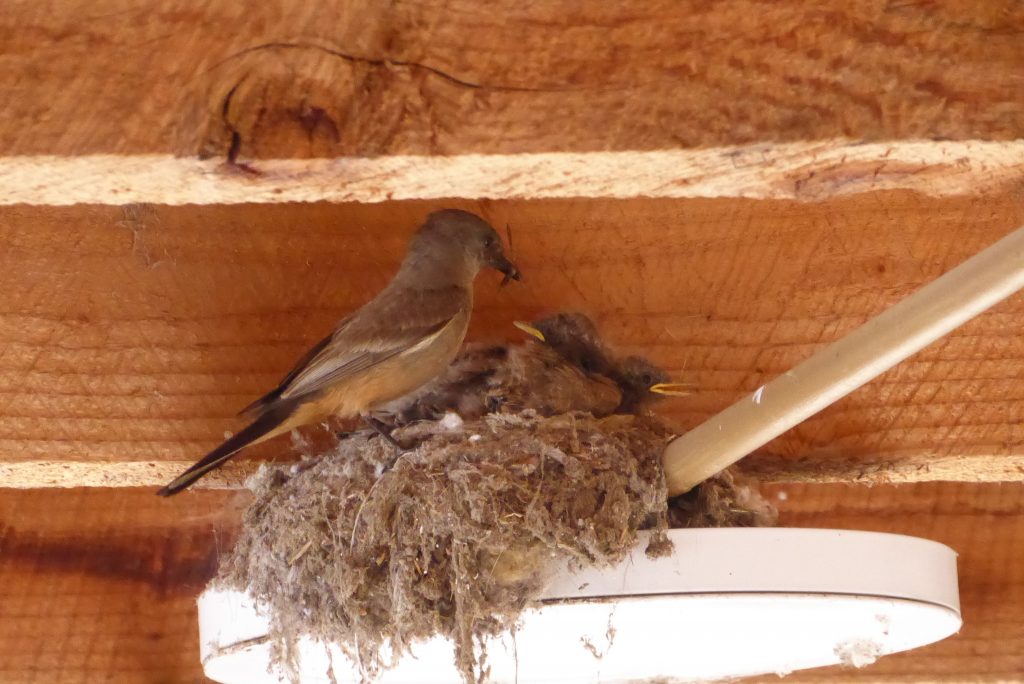

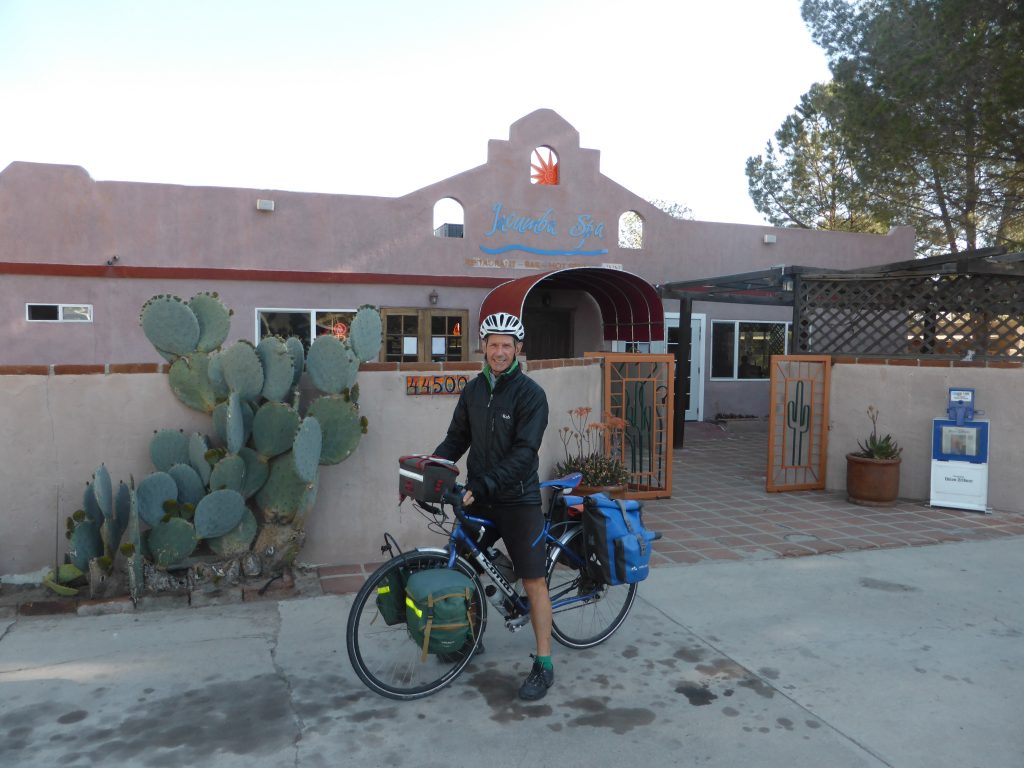
Cycling out of town on our penultimate day of the Southern Tier we passed the remains of the Jacumba Hotel, which had once boasted 65 rooms, a swimming pool and and area which operated as a roller skating rink during the day and then magically transformed to a dance floor at night. Today all that’s left is a fireplace and chimney and the footprint of what once was a grand destination.
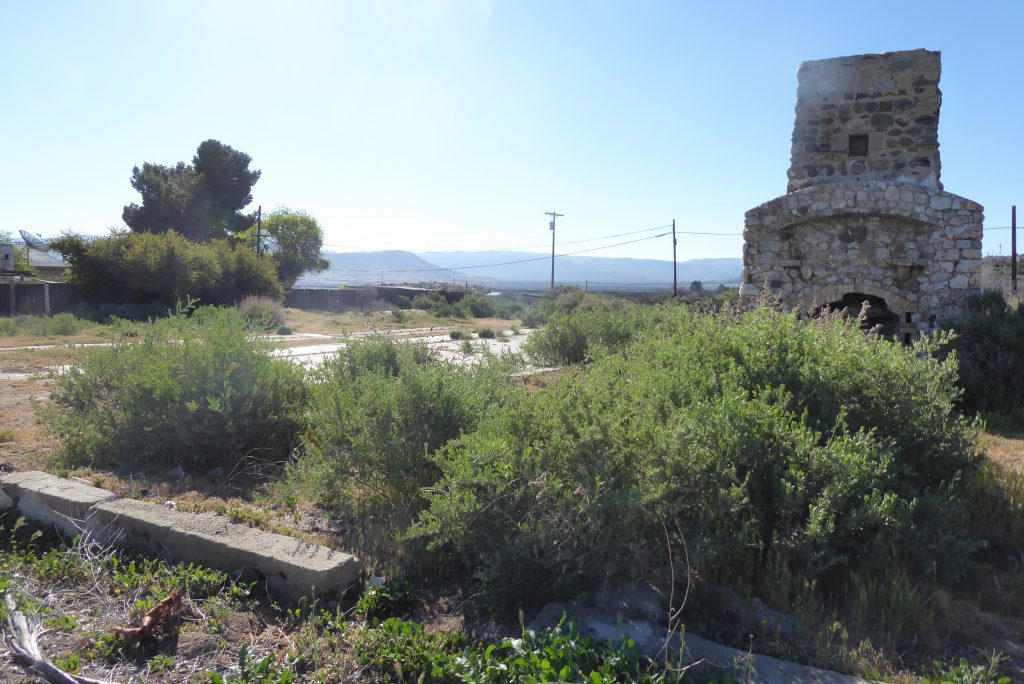
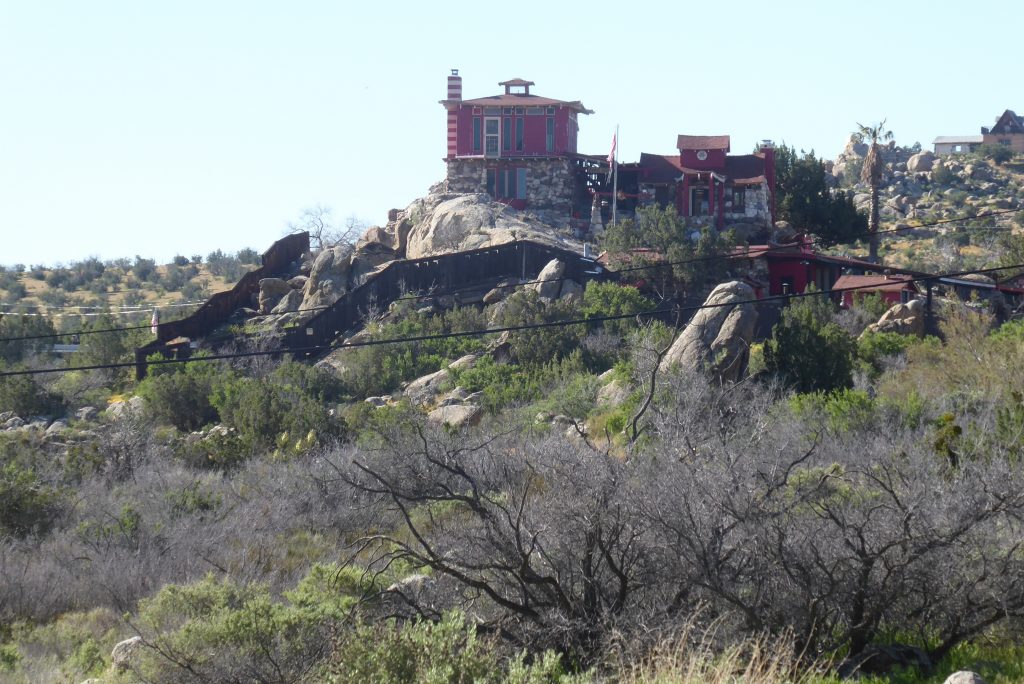
The most noticeable man made feature of the landscape is now not an Edwardian hotel, but an enormous metal wall, its top laced with circular twirls of barbed wire, and marking the border between the USA and Mexico.
Up until 1995 there was just an unmanned crossing between Jucumba Hot Springs and the neighbouring town of Ejido Jacumé, across the border in Mexico. According to the LA Times, while the border fence may have slowed illegal crossings it came at a price for the sister towns. What was once a 15 minute journey can now take hours. This in turn put the Hot Springs into further decline.
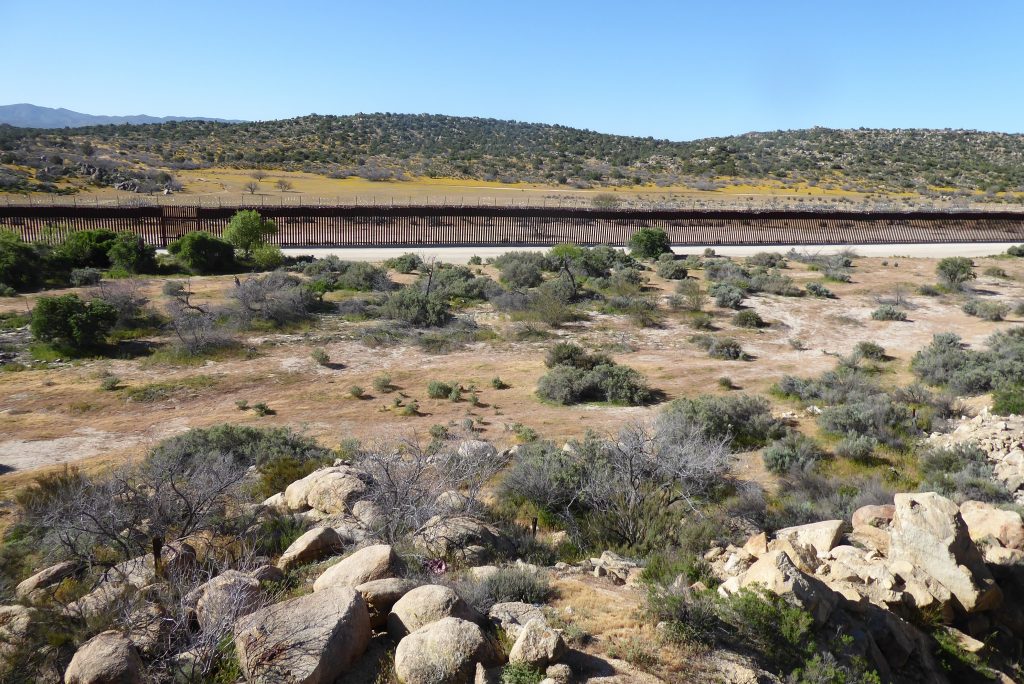
We knew from what Severo had told us that there were ongoing issues, but the wall didn’t seem to have stopped the heroin laden micro-light or the 90 year old woman with bags of drugs under her dress. The drugs gangs had just found different ways of getting their product into the U.S. Signs by the side of the road made clear that smuggling was a Federal Felony punishable with up to 10 years in prison.
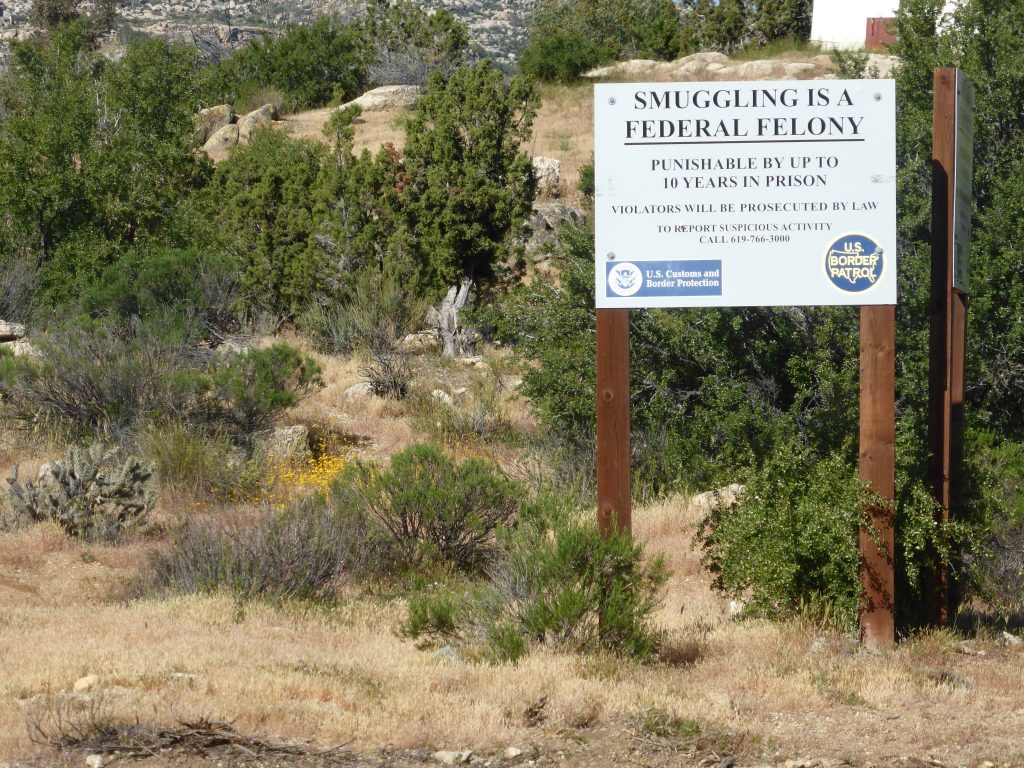
As we were standing and discussing the whys and wherefores as to whether walls have ever worked, a large bird of prey shot out from below the road bridge we were standing on and as we struggled to focus our cameras, a second bird flew out and settled on part of a telegraph pole much nearer to us. The birds turned out to be a pair of Great Horned Owls and their perches offered us a stunning bird’s eye view.
“Although there would be quite a bit of climbing today it would at least be manageable”.
From the profile on the ACA map we were expecting a stiff climb out of Jacumba, but the average gradient was around five degrees, suggesting that although there would be quite a bit of climbing today it would at least be manageable.
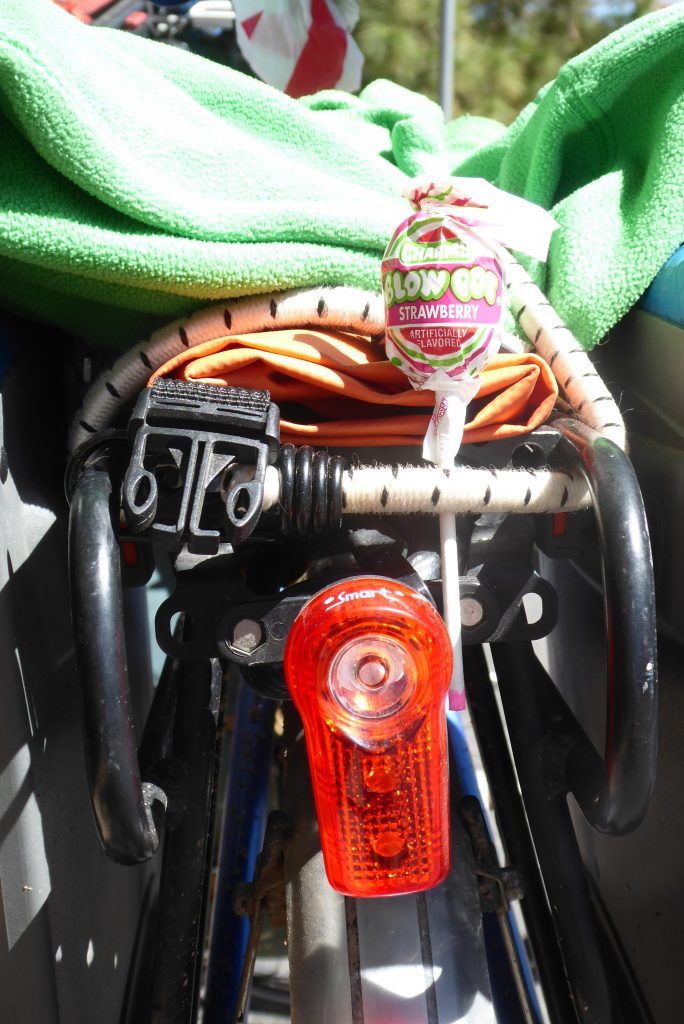
Sadly though there would be no rewards with long fast descents. The perilous state of my rear hub and the fact that I’d now also followed Terry’s advice and disconnected the rear brake, meant that I’d be tentatively tip-toeing my way down hill rather than whizzing down with wild abandon. Terry’s comment: “I wouldn’t even ride that bike down to the shop to get a new wheel” hadn’t filled me with confidence!
“Lizards basking on the warm stone cuttings suddenly began scurrying for cover when they saw us”.
Seeing the area in splendid daylight , we couldn’t help but notice how green the surrounding hills were becoming now we’d crossed the mountain pass. We’ve been in the desert so long we’d forgotten the familiar and comforting sight of grass pastures and verdant green trees. Going slowly up through the mountains small lizards basking on the warm stone cuttings suddenly began scurrying for cover when they saw us.
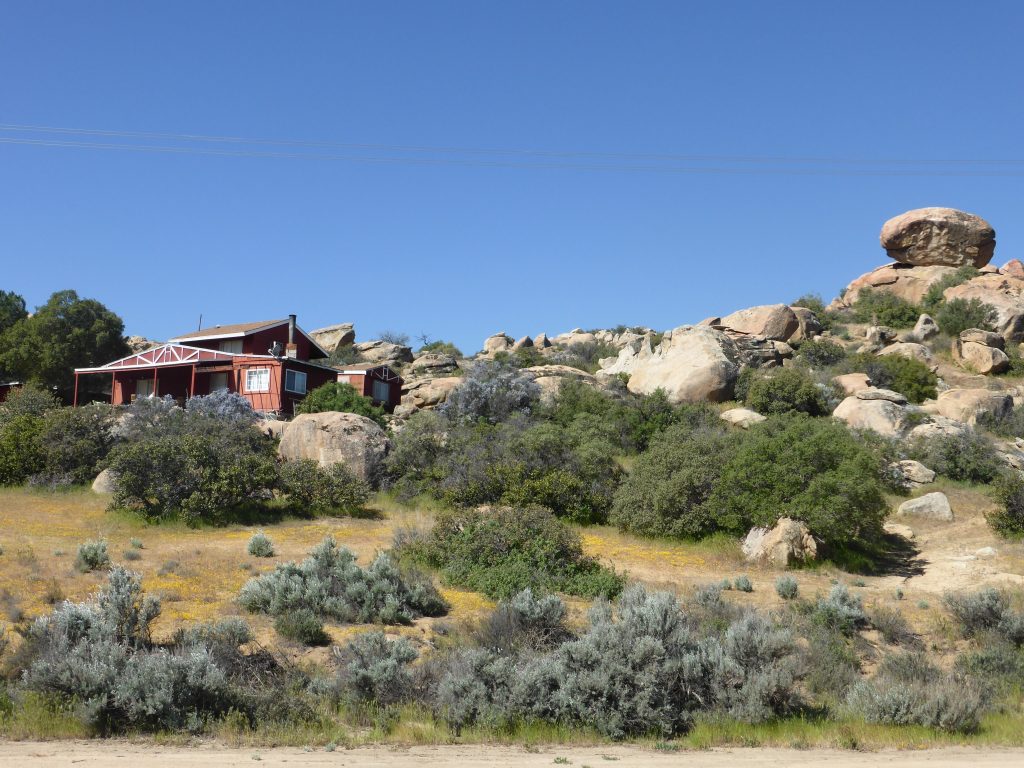
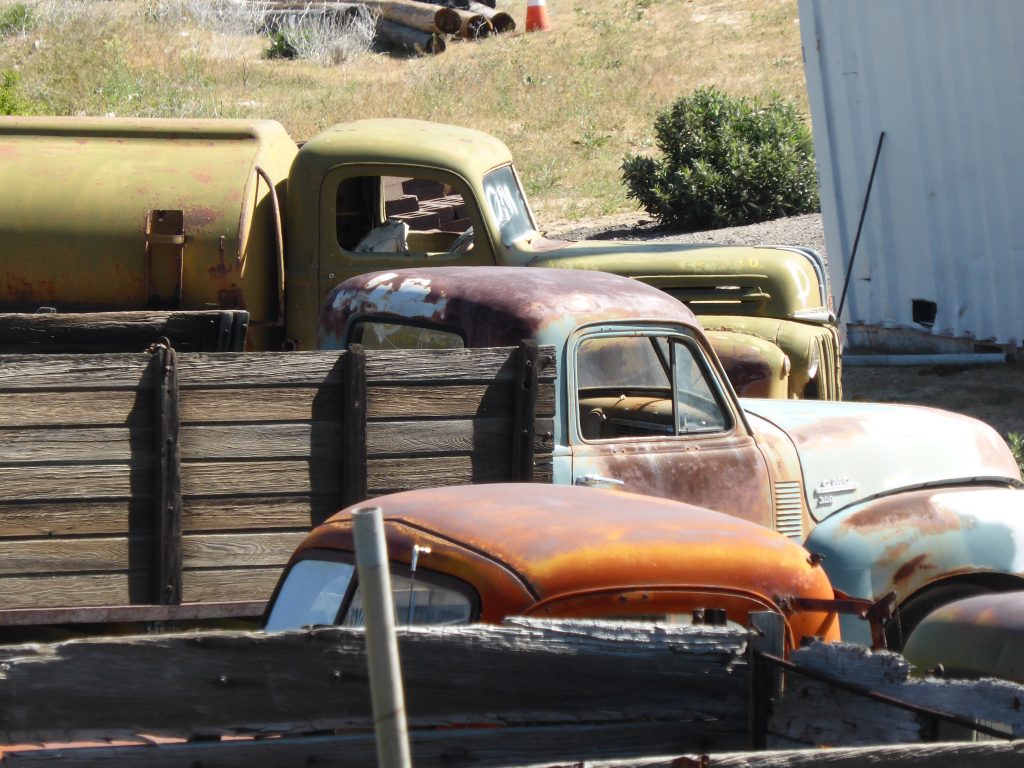
Everything unfolded in front of us – numerous peaks disappearing into a blue-green distant haze, high level trees on all the hillsides and carpets of colourful roadside flowers. In contrast, the few settlements seemed to major in ugly, rusty metal reclaim yards. Maybe the price of steel wasn’t worth the effort of anyone coming to tow them away.
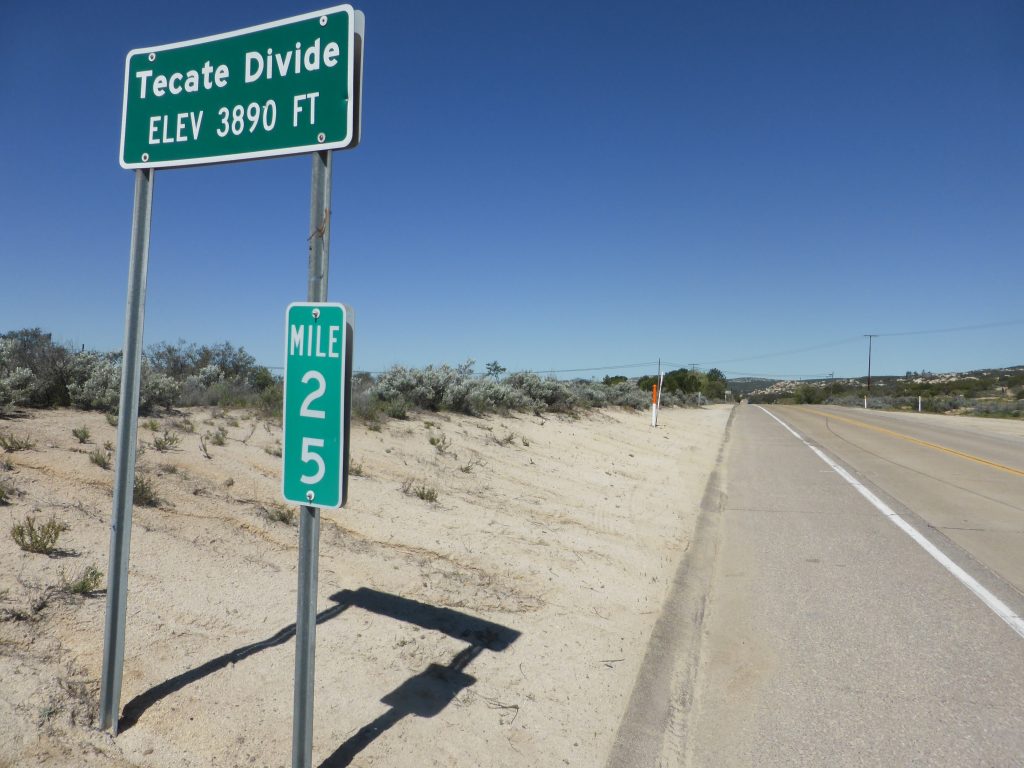
At 3890ft we crossed the Tectate Divide, a mountain ridge that runs north/south and passes between the towns of Live Oak Springs and Boulvevard. Anxious not to run into the same situation as yesterday and aware we still had climbing to do, I was keen for us to keep cycling rather than stopping for a break.
But as Terry rightly pointed out, there were some major differences – firstly we were doing all our climbing at the beginning of the day and not the end – and more importantly there was no wind! (In fact later in the day we even earnt the luxury of a slight tailwind). We were also blessed with a sunny day that required sun cream, but was tamed by the cool of the mountains.
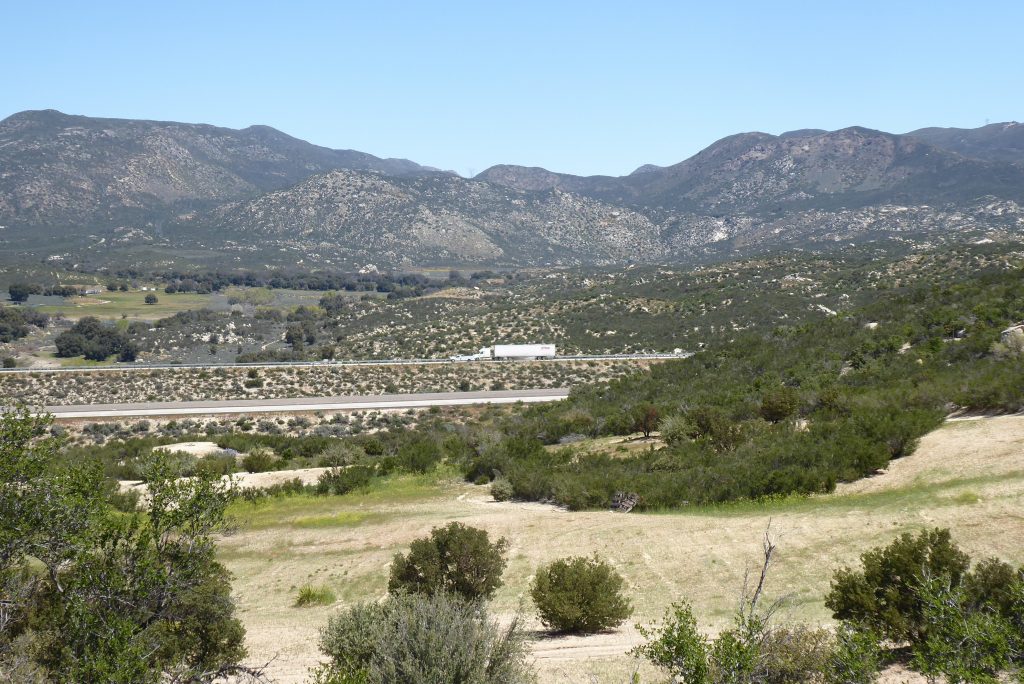
We saw hardly anyone, although presumably there are more people here than we realise as according to the map there are several small Indian Reservations in the In-Ko-Pah Mountains that we’re cycling through.
These are all neatly delineated with the straight lines and right angles drawn up by a victor that knows how to measure acreage by the dollar, but doesn’t see the value of tribal customs, lands or traditions. As if that ignomy isn’t enough the reserves are further sliced up by the Old Highway 80 and the I8.
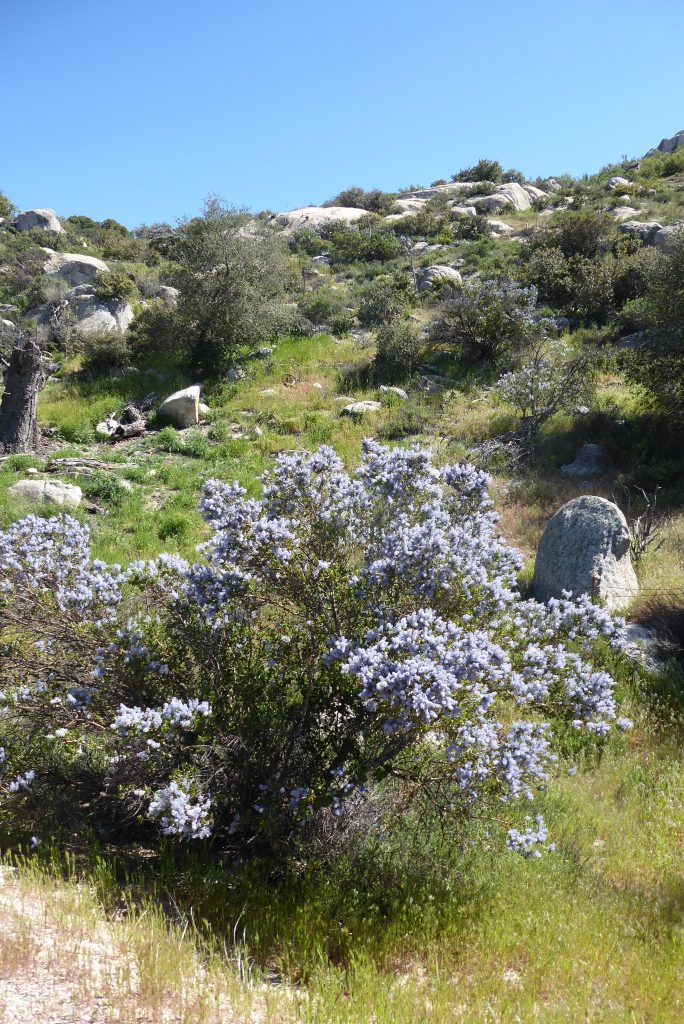
Moving through the In-Ko-Pah mountains the vegetation started to change yet again and Terry pointed out that we were beginning to see the distinctive blue flowers of the ceonothus, otherwise known as the California lilac.
These are a favourite in UK gardens, but we’d never seen them in the wild before, so there began our very own edition of ‘ BBC Gardener’s Question Time’, working out why it was there, soil types, climate etc (we are men of many talents).
“It was at that point we noticed a black and white Sheriff’s car had pulled up”.
Along with lots of pointing and discussion we also began taking photos of the best examples. It was at that point we noticed a black and white Sheriff’s car had pulled up by the side of the road about 100 yards behind us and our actions were being observed very closely. We imagined the conversation between the two officers went something like this…
“I don’t like the look of those two Hank – they’ve obviously stashed something up in those bushes and are trying to remember where they put it”.
“Good spot, Bob, but an unusual get up don’t you think – tight fitting black shorts and bicycles?”
“You say that Hank, but don’t you remember that old lady who hid all those drugs under her dress?”
“Good point Bob, but they aren’t going to get many grams into those shorts are they?”
“No, Hank, but look at the bags on those bikes – you’d have thought they’d be bulging with camping gear and stuff, but they look empty as if everything has been taken out”.
“Bob – you are on top form today! The District Attorney is going to love this one”!
“Hang on a minute Hank, can you hear those accents? Those two clowns are British – and we know what that means don’t we?”
“Oh crap, they are looking at the wild ceanothus aren’t they? Catches us out every time…”
“Doughnut Hank?”
“Great idea Bob”.
And with that they were off.
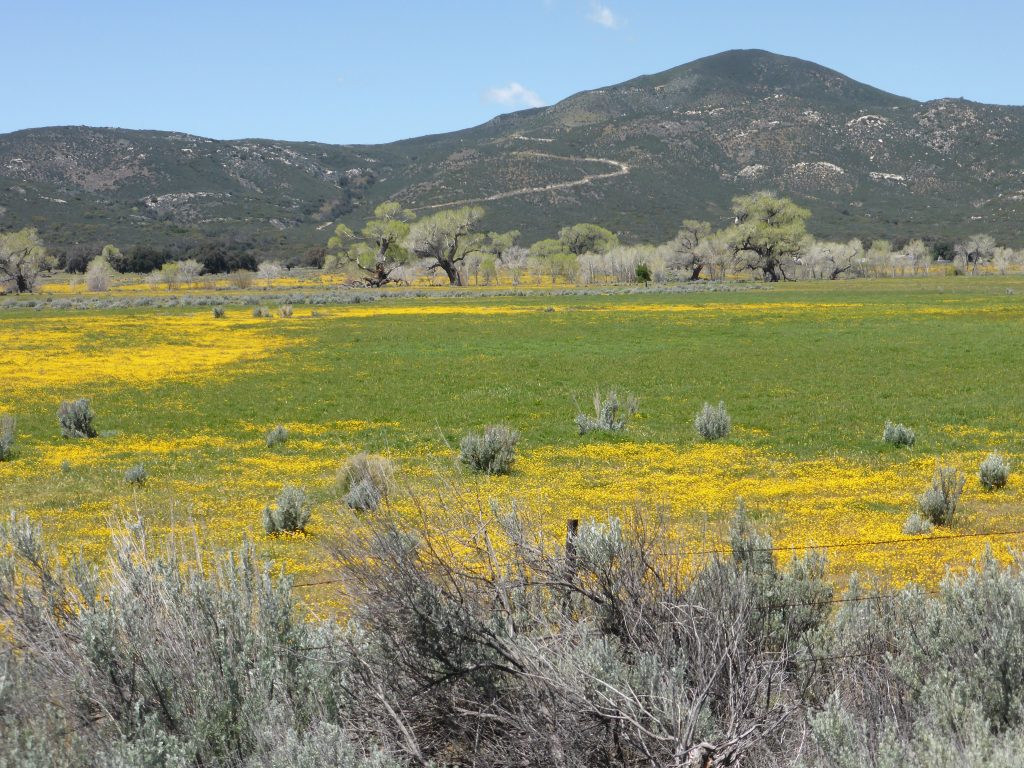
We continued to climb and descend throughout the morning and early afternoon and then, at around seven miles to the west of Live Oak Springs the Southern Tier crosses another of America’s most famous long distant routes – the Pacific Crest Trail.
The PCT starts in Campo, a small town on the United States/Mexico border, and goes through California, Oregon and Washington before reaching its northern destination in Manning Park, British Columbia – a distance of 2,650 miles. For the average hiker it takes four to six months to complete.
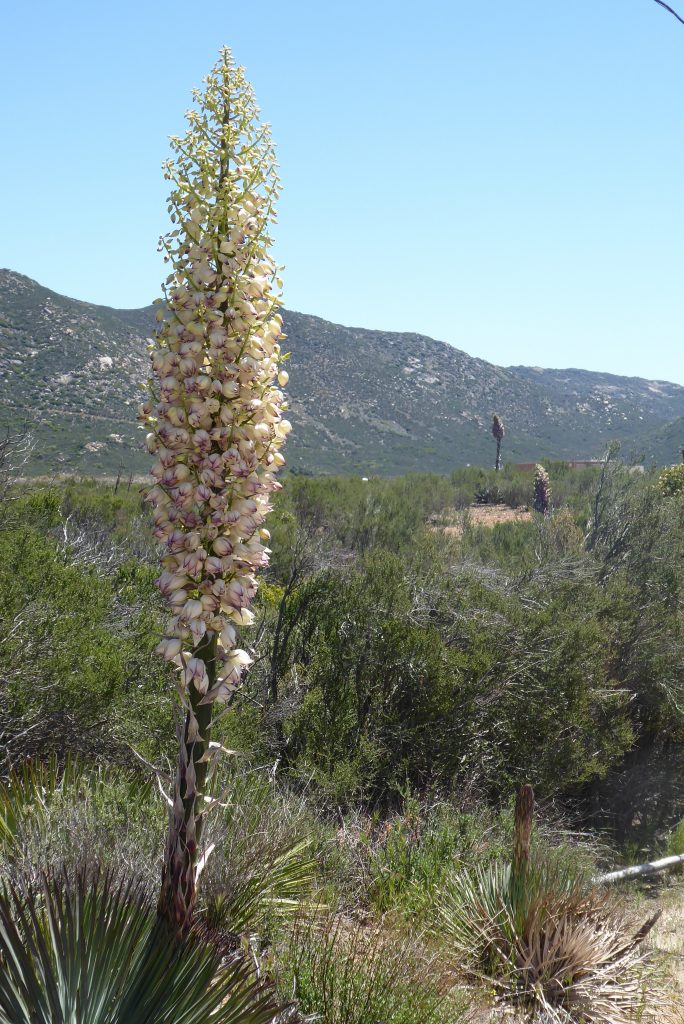
Looking across a meadow, awash with tiny yellow daisies, we could see the trail winding down the slopes of Sheephead Mountain, but our eyes were distracted by another magnificent bird of prey which flew low, drew back its wings and landed in some scrubby plants. It appeared to be some kind of harrier, but whether it had landed to rest, or to take prey, we never did find out.
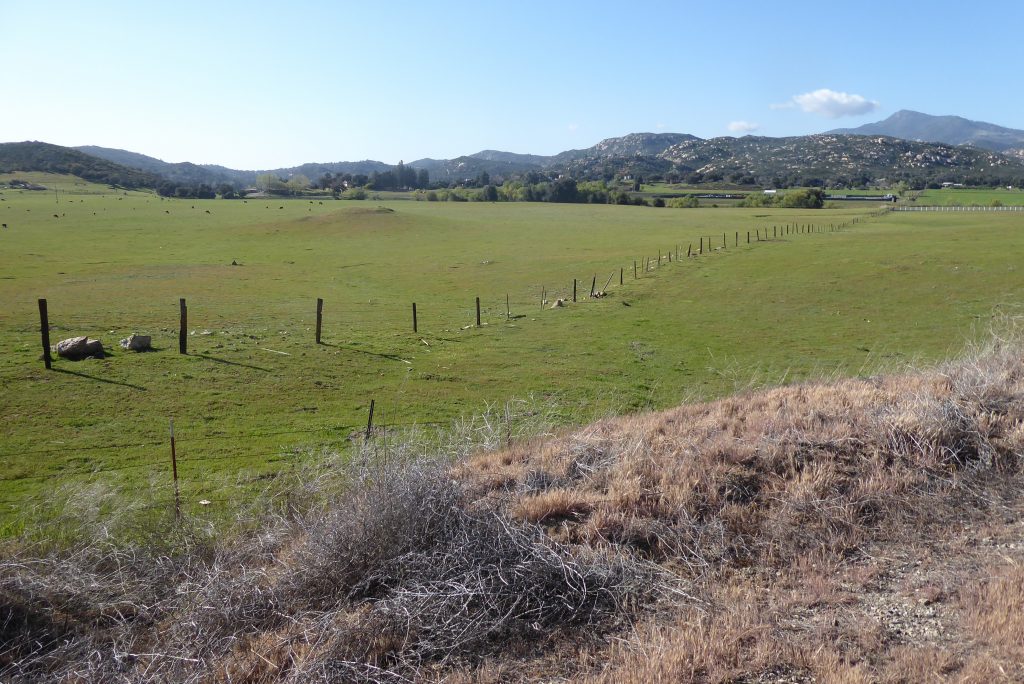
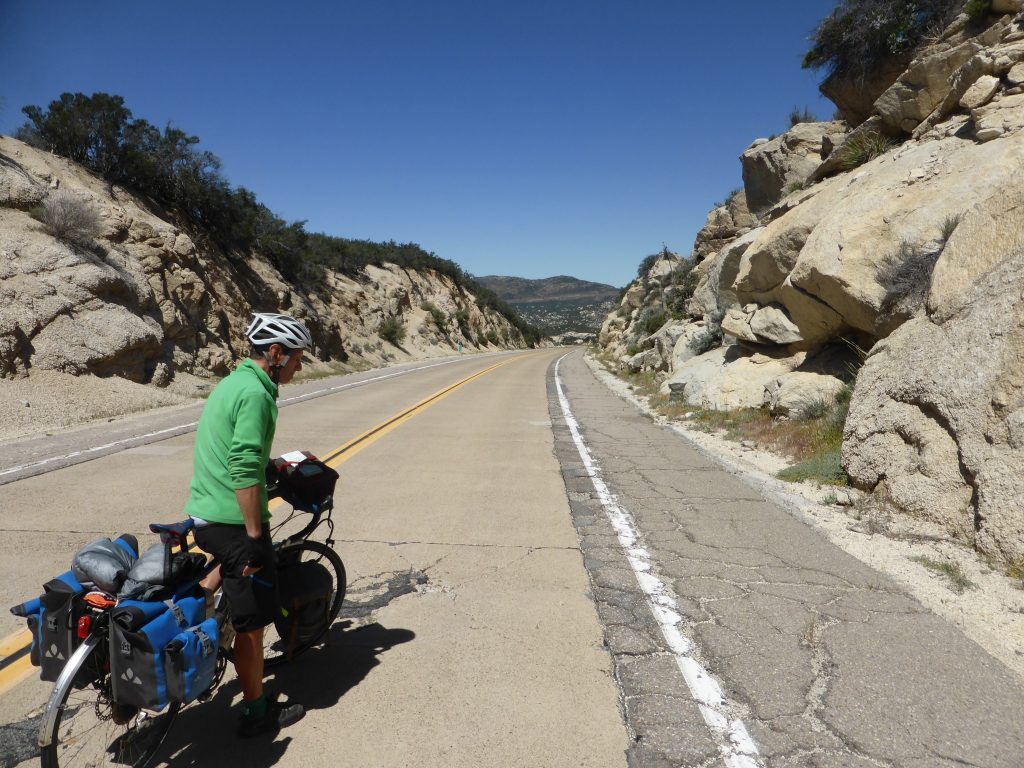
Our route on Old Highway 80 had, for most of the day, been roughly following the path of the road that supplanted it, the I8, but at Pine Valley (named after the Jeffery Pine found along the creek) it regained its independence and looped north.

Pine Valley lived up to its name – almost alpine and very green. That’s because it rains a lot up here. Ironically, the big storm that went through last November caused $8m worth of damage, as it bought down power lines and resulted in a lot of fires. Now if there’s a storm warning, the utility company just turns the power off until it’s all clear.
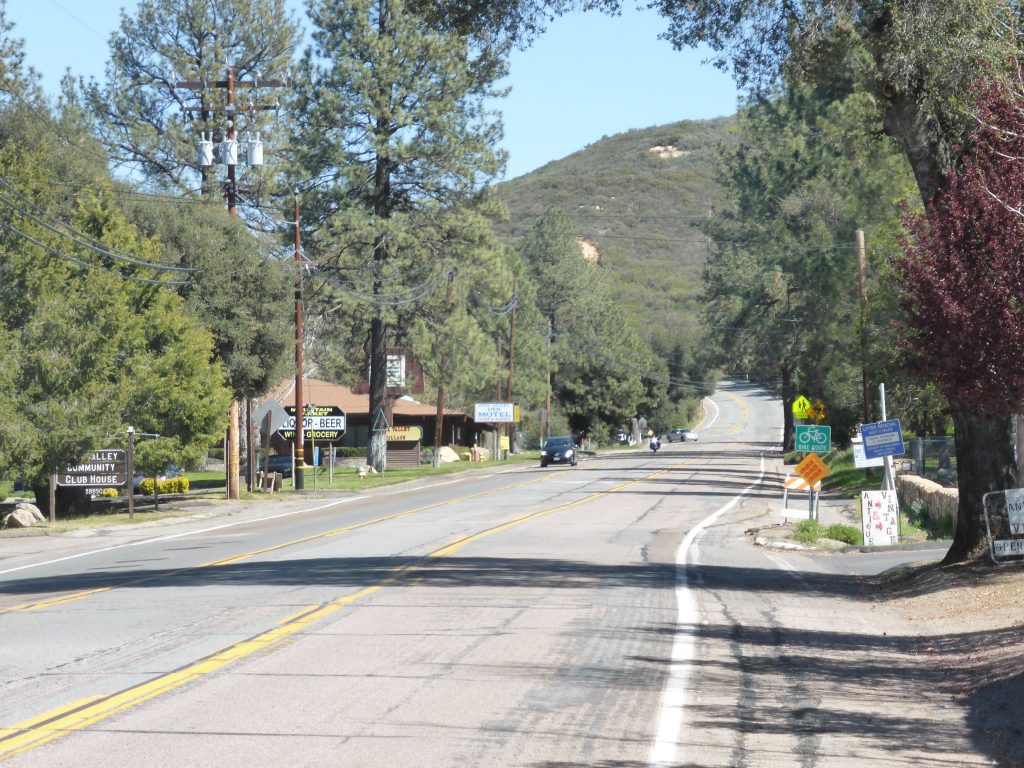
As the owner of Majors Diner told us, that meant the last time the weather kicked off she had to shut down the business and ship out of town for five days until normal service was resumed. Most of the residents went to stay in Alpine, our destination for the night, before it passed.
Thankfully, with few clouds in the sky, we were able to savour the diner’s delights which, with its 50s decor and music, was trying to capture the heyday of a bygone age – and seemingly succeeding Although what Elvis would have made of avocado toast I’m not sure.
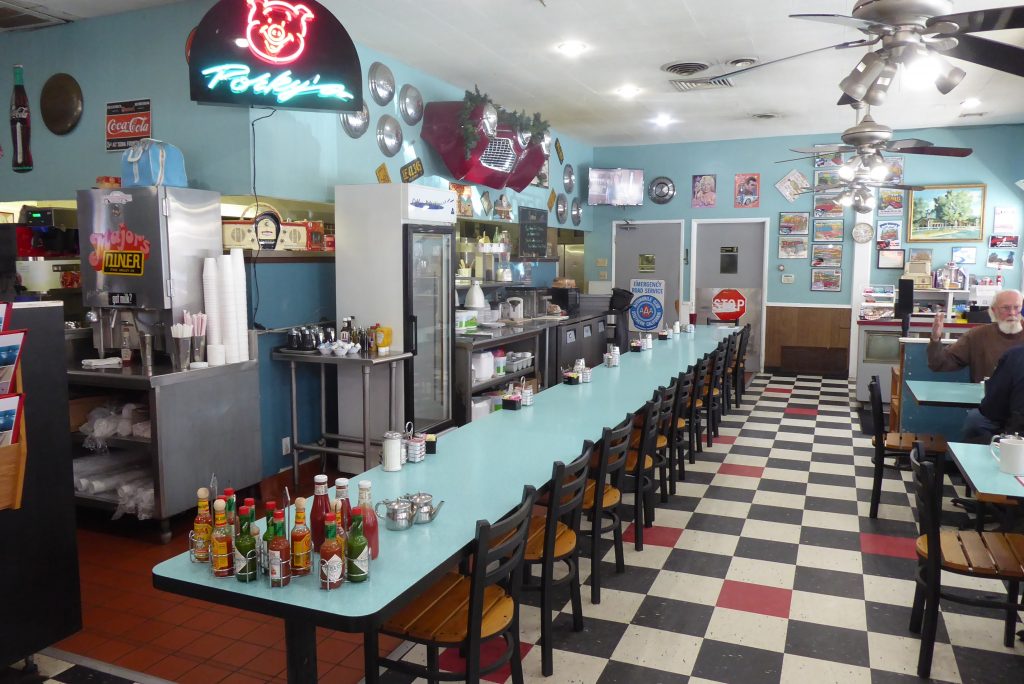
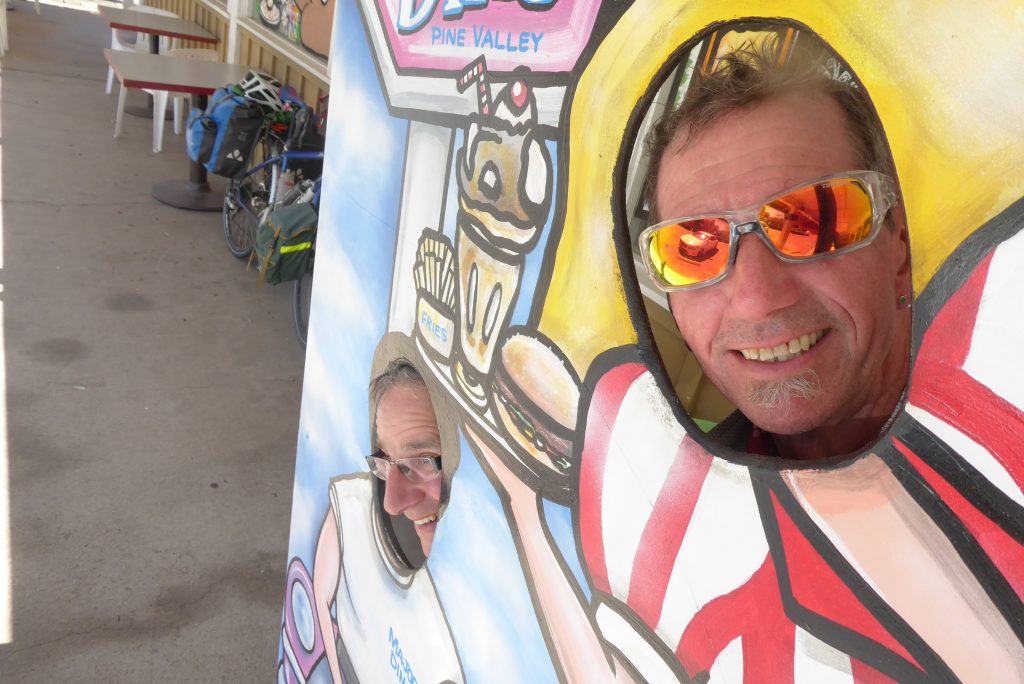
As we moved west the air was getting cooler, the scenery much greener. There were trees and flowers. The change on this side of the mountains was quite extraordinary. It was like entering a different country, a different continent. A world away from the desert in the east of the state, this was much more what we expected of California, far greener – and wealthier.
“Terry is amazed we’re still cycling and hasn’t had to scrape him me off the floor yet”.
One final pull up and around Guatay Mountain and we were rewarded with the prospect of a 4,000ft drop down to sea level and San Diego. Only slightly annoyingly, we have to do it very slowly due to my rear wheel! Terry is amazed we’re still cycling and hasn’t had to scrape him me off the floor yet. Mind you, the lack of speed gives us lots of time to take in all the impressive scenery, which is getting more and more like England as we lose height.
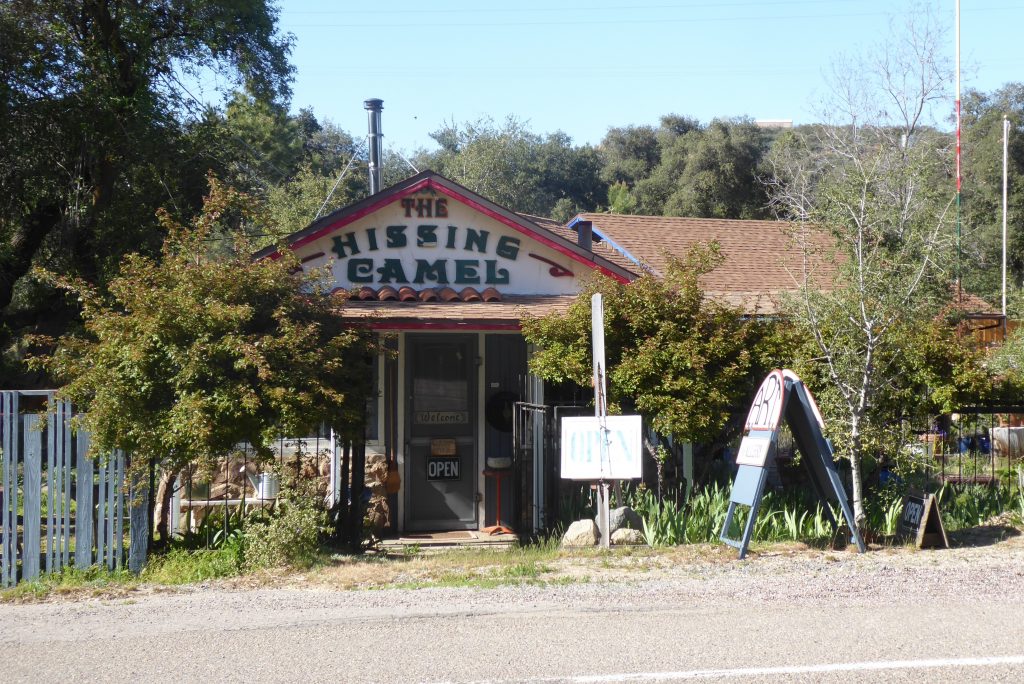
In Guatay, a small mountain community, we cycled pass a building which announced itself as The Hissing Camel art gallery. The word ‘Open’ was nailed up by the front gate. Knowing how much Terry loves art I suggested we turned back and took a look. Terry immediately dismissed the idea claiming it would either be 1) closed or 2) rubbish.
Having had numerous conversations about what constititues ‘art’ over the last couple of months, I took umbrage at his negative response. I’m supposed to be the philistine with no imagination, yet here was Mr Arty Farty dismissing going past without even taking a look. “It might be interesting,” I say. “It could contain the next big thing? How can you call yourself an art lover if you ride straight past?”
“Feeling vindicated, Terry walks away … just as the door is unlocked and opened”.
Eventually Terry conceded I have a point and we pedal half a mile back up the hill. I can tell from his demeanor he thinks it’s a waste of time. It’s closed. Terry raises his eyebrows in mock surprise as if to say “See, I told you so”. We go round the back. It’s locked. Feeling vindicated, Terry walks away … just as the door is unlocked and opened.
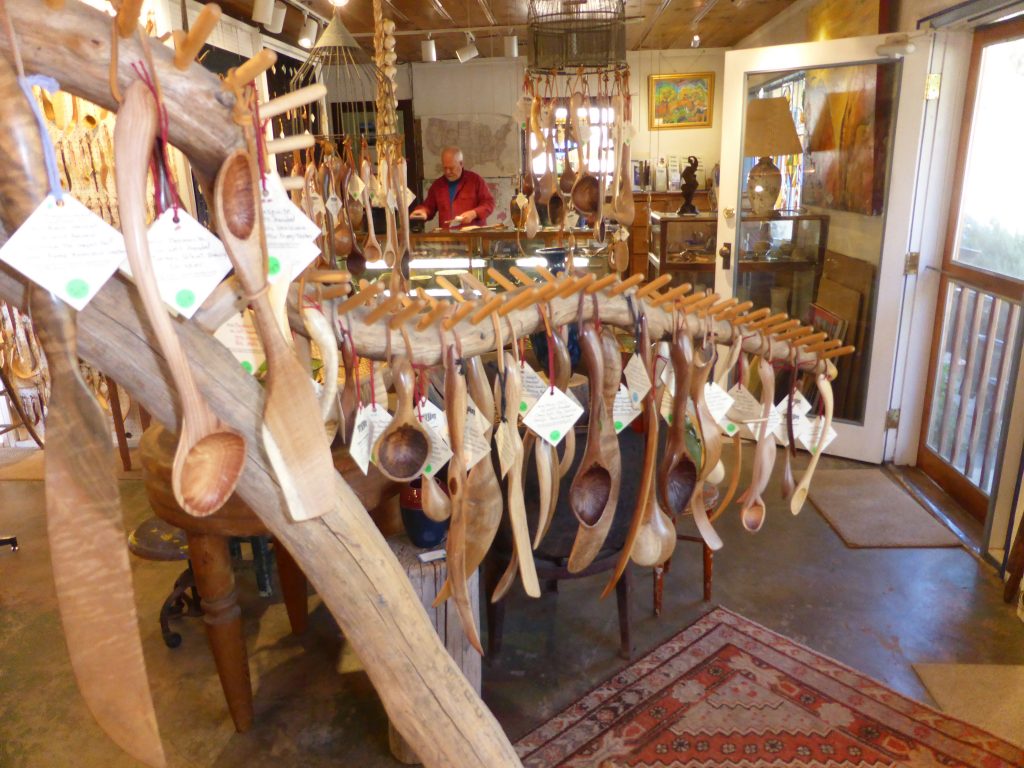
Inside the walls are covered in hundreds of small, beautifully carved and polished wooden kitchen utensils, mostly spoons. They had all been hand made by William, the gallery owner, who showed us around and described the different woods he uses with each piece. His passion is infectious. Each utensil has a very specific use and is labelled as such: ‘3rd Time Round Wedding Cake Knife’, ‘Olive and Marmalade Chutney Scoop’, and ‘Darling, We’re Going on a Diet, Buritto Cutter’.

There’s also pottery by David Leach (the son of British potter Bernard Leach, ) a Sam Maloof rocking chair, which is exquisitely crafted in walnut burr (a snip at $12,500) as well as glassware, various paintings and Paolo Soleri bells. Terry is like the cat that got the cream.
I bought a spoon for Kate, carved out of a 400 year old mesquite tree. The label reads: ‘Super Savory Vegetarian Lima Bean Soup Taster’. William explains that the mesquite is a tree whose story is interwoven with that of the Native Americans. The trunk of the tree from which the spoon was carved had a five foot girth and he had found it, left outside his studio, 30 years before.
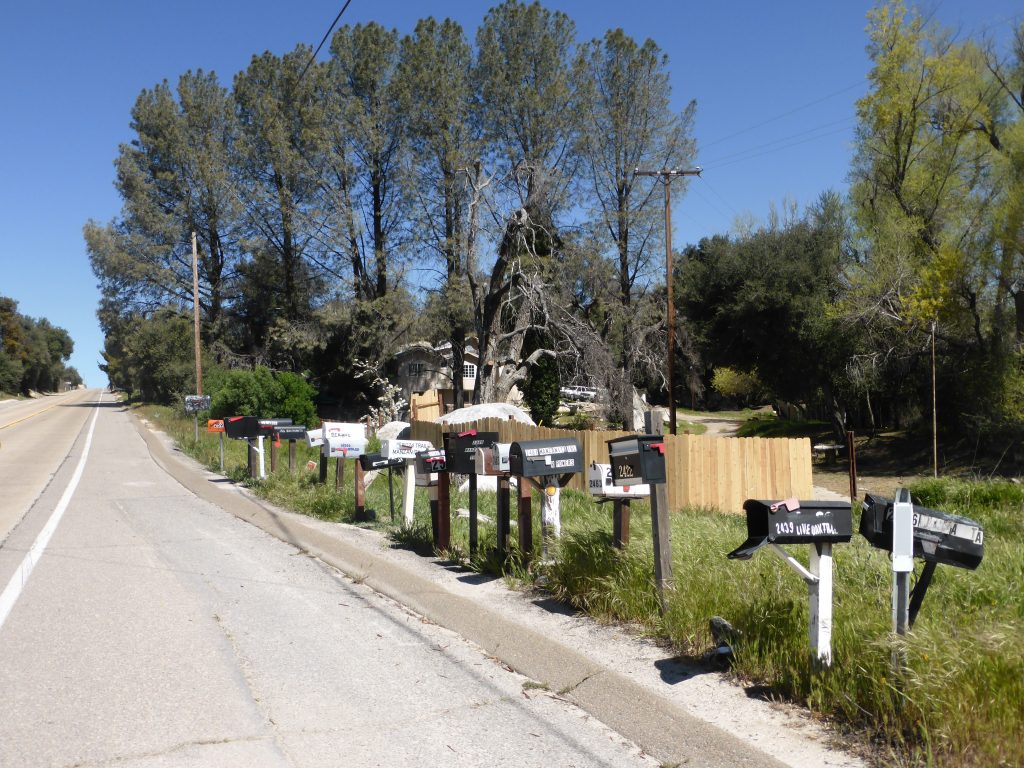
It’s not often I get to be smug, but Terry says my ‘I told you so’ face lasted all the way to our nightstop in Alpine and I could tell he was secretly hoping my wheel would collapse to take the grin off my face. The truth was that I was smiling at the scenery – and our gentle freewheeling downhill.
After making the last climb of the day we were finally over the mountains and as we descended into the valley were blown away by the transformation – green grass, green trees! Wonderful! The desert had been beautiful and dramatic, but we realised now how much we had missed vegetation and this felt like home, the green green grass of home in fact!
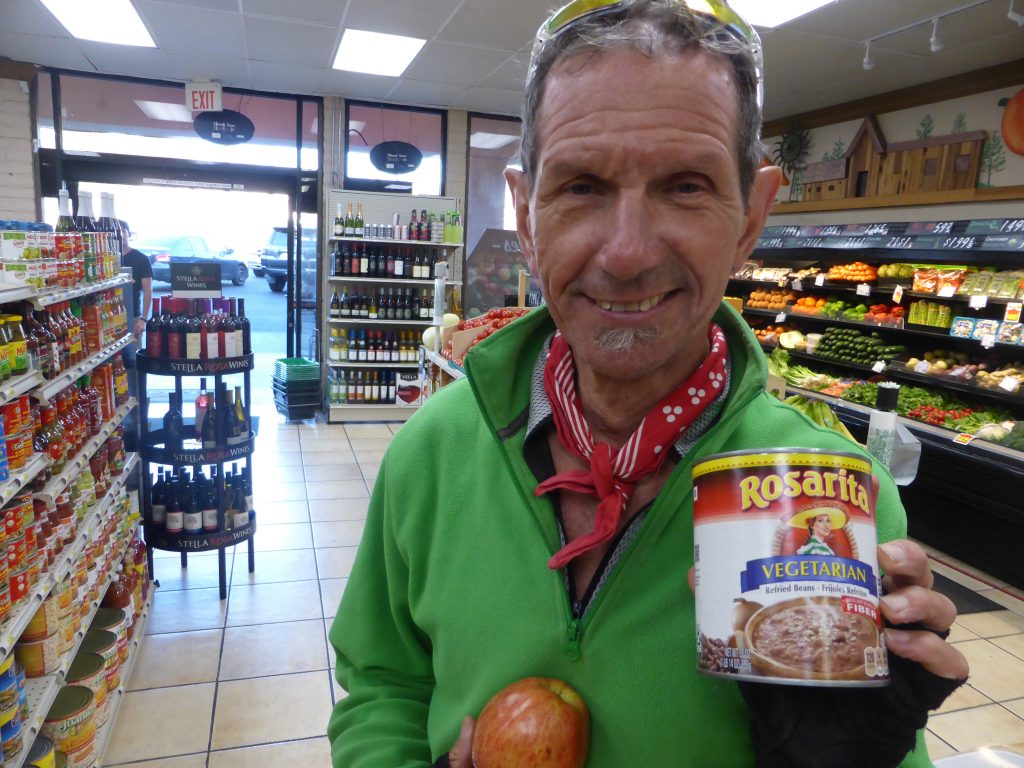
From there it was downhill all the way (almost) until Alpine our last overnight before San Diego. At $110 our hotel was expensive, so to save money we dropped into a local grocery store to replenish our supplies and use up the last of the ramen noodles, supplemented by vegetarian refried beans. Amazingly we are now so close to the Pacific we can almost smell the salt.
Today’s miles: 47.24
Total miles since Anastasia State Park: 3,039.6
